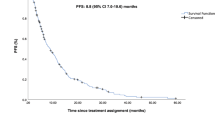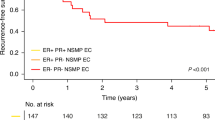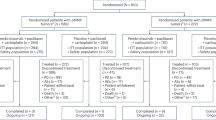Abstract
A randomized trial to compare adjuvant treatment with an alternating regimen with conventional chemotherapy was performed. A total of 589 node-positive patients were included and stratified according to number of positive nodes (N1-3 and N > 4) and menopausal status. Premenopausal N1-3 patients were randomized to cyclophosphamide, methotrexate and fluorouracil (CMF) or CMF/4'-epirubicin, cyclophosphamide (EC), post-menopausal N1-3 patients to fluorouracil, 4 epirubicin, cyclophosphamide (FEC) or CMF/EC and pre- and post-menopausal patients with N > or = 4 to fluorouracil, 4' epirubicin, cyclophosphamide, methotrexate, prednisone (FECMP) or CMF/EC. In premenopausal patients, CMF was superior to CMF/EC in terms of disease-free survival (DFS) (65% vs 45%, P = 0.0149) and survival (72.3% vs 50.2%, P = 0.0220) whereas, for N > or = 4 patients, differences between FECMP and CMF/EC did not achieve statistical significance (DFS 35% vs 26.2%; survival 50% vs 38.1%, P = NS). For post-menopausal patients, FEC was superior to CMF/EC in DFS (58.6% vs 36.8%, P = 0.0215) and survival (66.2% vs 46%, P = 0.0155). In post-menopausal patients with N > 4, differences favouring CMF/EC were significant in DFS (40.4% vs 22%, P = 0.0371) but not in survival (47.4% vs 32.2%, P = 0.1185). Alternating regimens did not offer better results in premenopausal and post-menopausal N1-3 patients. Results regarding post-menopausal N > 4 women require further confirmation.
This is a preview of subscription content, access via your institution
Access options
Subscribe to this journal
Receive 24 print issues and online access
$259.00 per year
only $10.79 per issue
Buy this article
- Purchase on SpringerLink
- Instant access to full article PDF
Prices may be subject to local taxes which are calculated during checkout
Similar content being viewed by others
Author information
Authors and Affiliations
Consortia
Rights and permissions
About this article
Cite this article
Chacon, R., Romero Acuña, L., Blajman, C. et al. Less efficacy with alternating regimen as adjuvant chemotherapy in stage II node-positive breast cancer: results at 8 years (Pronacam 85). Br J Cancer 76, 545–550 (1997). https://doi.org/10.1038/bjc.1997.423
Issue date:
DOI: https://doi.org/10.1038/bjc.1997.423
This article is cited by
-
Cancer as a robust system: implications for anticancer therapy
Nature Reviews Cancer (2004)



